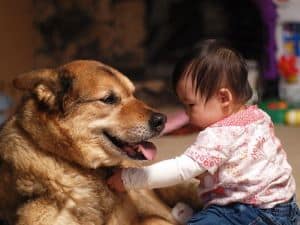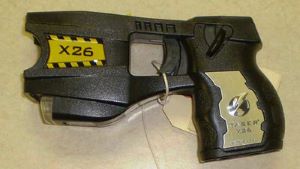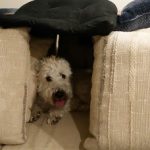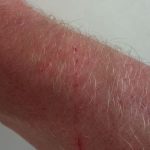Have you just noticed that your not so charming dog is startling your beautiful baby when they bark?
Has it got to the point where you can’t tolerate the yapping any longer?
Well in this article I look at how noisy our homes are and how precious a baby’s hearing is.
Let’s start with our main focus, which is all about how noisy a dog bark is and how much loud noise a baby’s ears can tolerate.
Can dog barking hurt babies’ ears?
Looking at some simple statistics, a dog bark can easily hurt a baby’s ears in the fact a bark is loud enough to damage them.
It is thought that the loudest sound that babies can tolerate is around 80- 85 decibels.
What is interesting is that noise level is the same for any person regardless of age: be it a baby or a grandmother.
The loudness of a dog bark depends on a few factors but most important is the breed.
It is thought that the quietest dog bark is about 60 db and that the breeds with the quietest barks are wolf breeds, such as the Chow Chow or Afghan Hound.
One of the breeds with the loudest bark is a Golden Retriever.
In 2012, the bark of a goldie named Charlie was recorded at just over 113 decibels.
You can hear it on this video.
Of course, as well as how loud a particular breed of dog can bark another issue to consider is how often a dog barks.
So, for instance although Charlie has the loudest bark, Golden Retrievers aren’t considered to be the most frequent barkers.
That prize goes to Beagles or Yorkshire Terriers.
Having established that a baby’s ears can be damaged by a dog barking, I will now move on to explore other household sounds that might present a danger to your baby’s hearing.
Common household sounds that too loud for baby
There is a certain irony that a baby’s hearing can be damaged by exposure to noise that regularly exceeds 85 dB and yet their own cries can regularly exceed that level.
Babies are individuals whose cries and wails are unique but it is thought that many exceed 100dB and some can reach up to 130 dB.
But the interesting thing about a baby’s cry is not only it’s volume but it’s pitch that activates specific areas of the brain to release the “love hormone”, oxytocin.
There are six other sources of noise commonly found in homes that could harm a baby’s ears if they aren’t used with extreme caution.
Yelling
An adult who is shouting and yelling often exceeds 85 dB and can reach 90 dB.
The stress and strain that parents are placed under as they care for a baby unfortunately might mean that shouting and yelling are more likely to be heard in the house!
Loud music and hoovers
The next threat to delicate hearing is loud music. Although a radio played at an average volume comes in at around 75 dB (the same as a hoover) a bigger music system can blast out music at about 100 dB.
Smoke alarm
In the U.S. a smoke alarm must make at least 75dB of noise.
Is there a household noise that can go through you as effectively as a smoke alarm? Well, apart from a baby…
Power tools
Most power tools operate at noise levels between 100 and 110dB.
Toys
Toys, I hear you say?
Toys are incredibly loud
In 2011, researchers at the University of California measured the noise levels from some of the year’s most popular toys.
The levels were measured right next to the toy’s speaker and then again at (a toddler’s) arm’s length.
The toys included Buzz Lightyear, Sesame Street’s Elmo and a Tonka Fire Truck.
The noise levels from all of the toys when it was measured at their speakers was between 90dB and 95dB. When they were measured at arm’s length they measured between 60dB and 75dB.
How loud can babies tolerate?
Earlier I told you that babies can tolerate noise levels of around 85dB but that they should not be exposed to these noise levels for prolonged periods.
If they are, babies are in danger of suffering what is called noise induced hearing loss.
Loud noises (it can be a one off event or a series of events) damage tiny hairs in the inner ear.
These hairs detect noise and translate it into electrical signals which are sent to the brain.
Loud noises damage these hairs so much that they are “beyond repair”.
Having looked briefly at the damage that loud noises or loud environments can have on a baby, in the next section I will give you a few pointers- checks that you can do at home on your baby’s hearing.
Typical hearing and listening behaviour for babies
In this section, I will briefly discuss some hearing and listening behaviours that a baby of different ages will normally “show”.
However, it is important to state that a home test in no way replaces the need for a proper clinical assessment.
If you are worried at all, you must contact your health provider.
A full description of these behaviours can be found here.
The hearing and listening skills show how hearing develops from birth to 7 months of age.
Examples of some key behaviours include that in the first month of life most babies will stir from sleep in response to sounds, in the first four months of life a baby might quieten and become tense in response to a sound and that by the age of seven months, many babies appear to “listen.”
In my next section, I want to go back to our original concern which was around dog barking and look at how we can stop a dog from barking or at least try and get it to be quieter…
How to stop a dog barking
Most family dogs love babies.
They very quickly figure out the important place that a child has within the home and from then on will try their best to understand them.
I have a two year old grandson and my youngest Golden retriever loves him.
I mean he confuses the hell out of her because he will move suddenly, push her out of the way and carry balls and biscuits at the same height as her mouth but there is little doubt that she idolises him.
Syvlie has a special way of greeting people that she really, really likes and that is to do a long but gentle growling noise, which at the moment scares him half to death.
But, what is the best way of stopping a dog from barking?
The first thing to do is to make sure that your dog has enough physical exercise from daily walks and if necessary some mental challenges such as obedience games, fetch and retrieve or agility training.
The next thing to try and figure out what is causing the barking?
Is it in reaction to one particular person (such as a husband or wife?)
Or one specific event, such as a person to your front door?
Here is an excellent set of tips which can be used in a variety of contexts which will help you to train your dog to stop barking.
There are essentially six steps to work through using this technique.
Implementing this training with your dog has numerous benefits:
- Your home becomes quieter for your baby
- You strengthen your relationship with your dog
- You provide your dog with additional mental stimulus, which will also help to reduce barking.
Closing Thoughts
I hope that you have enjoyed reading this article as much as I have enjoyed writing it.
A dog’s bark can hurt babies ears in two possible ways.
Firstly as a one off event, which will easily exceed the 85dB level and secondly if your dog spends quite a lot of its day “yapping” then that could also damage hearing over a period of time.
But it is important to recognise that a dog’s bark is not the only threat to your baby’s hearing.
Our homes are cluttered with objects and machines which if not used with care are too loud.






